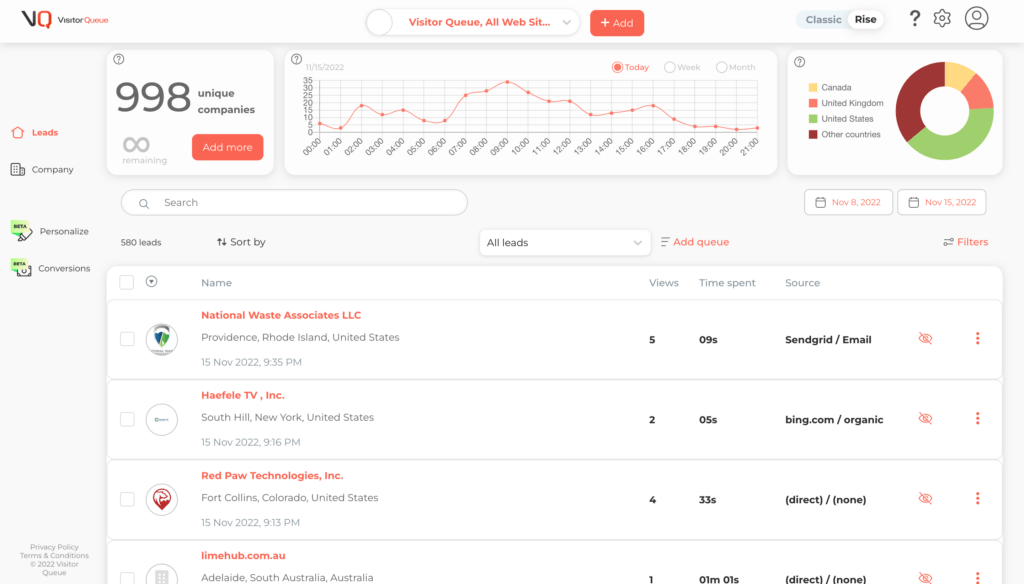No matter the industry you are in, or where you are located in the world, as marketers we are always looking for new ways to increase sales. But, with the market constantly changing, it’s difficult to figure out where to invest your time and money in order to increase B2B sales. That’s exactly why we made this comprehensive guide to increasing B2B sales through marketing. Before we jump right into the tips, let’s go through the differences between sales and marketing.
Sales vs Marketing
Sales and marketing are often viewed as different parts of a company, with their own separate goals and strategies. While sales teams focus on converting leads into customers, marketing plays a crucial role in creating awareness, generating interest, and nurturing leads. Marketing efforts should provide your sales team with high-quality leads. While sales teams should offer valuable insights to help refine your marketing strategies. By aligning your sales and marketing teams, both teams will be able to better serve customers.
Inbound vs Outbound Marketing
Understanding the differences between inbound and outbound marketing is essential for creating a well-rounded strategy. Inbound marketing involves attracting prospects through content creation, SEO, and social media. On the other hand, outbound marketing reaches out to potential customers through methods like cold calling and cold email campaigns. A successful B2B marketing strategy often combines elements of both inbound and outbound marketing strategies. While inbound typically generates more organic leads, outbound can help target specific industries or companies.
Utilize Your CRM
Your CRM should be a vital part of your sales and marketing strategies. It not only keeps track of your contact information, but it can also streamline communication between sales and marketing teams. By tracking customer interactions and providing valuable insights, your CRM will enhance lead management. And, ultimately can contribute to higher conversion rates. Investing in a CRM system can truly make the difference between a lead converting and a lead getting left behind. Now that you know the basics of sales and marketing, let’s jump into how you can increase B2B sales through marketing.

Increasing B2B Sales Through Marketing
Unfortunately, there isn’t a one-size-fits-all approach to increasing B2B sales through marketing. But, here are a few of the top marketing strategies that are sure to impress.
Targeted Content Creation
Knowing who your target audience is, is one thing. Creating content that they will want to see is another. It’s best to develop content that resonates with your target audience. Create blog articles, whitepapers, eBooks, webinars, and case studies that address the pain points of your potential clients. To go one step further, try to tailor your content to different stages of the buyer’s journey, from awareness to decision-making. This will increase the likelihood of your prospects following through to the point of purchase.
Create Educational Content
By providing valuable insights, industry knowledge, and actionable tips, you can position your company as a thought leader and a trustworthy resource. Try to build comprehensive guides, tutorials, and blog articles that address the challenges your prospects face. This not only establishes trust but also positions your brand as an authority in the field. There is a general rule of thumb when it comes to content, where 80% of your content should be focused on education, while the rest should be selling your product or service. After all, an informed prospect is more likely to convert into a happy customer.

Marketing Automation
Implementing marketing automation allows you to speed up time consuming processes, reduce errors, and ensure your leads are properly taken care of. From lead scoring to email campaigns and social media scheduling, marketing automation can allow your team to focus on more pressing tasks. It also enables to you track and analyze the performance of your campaigns, providing valuable insights for continuous improvement. A remark that I often hear is that companies don’t know where marketing ends and sales begin – with marketing automation, you can let technology handle this. And, when the prospect is ready to book a meeting, your sales team will be ready and know exactly what they are looking for. If you’re looking to get started with marketing automation, take a look at What is Marketing Automation and How to Get Started.
Social Media Engagement
If you’re focusing on increasing B2B sales through marketing, social media is a great place to start. Try to leverage social media platforms to connect with your audience. Share your helpful content, participate in relevant discussions, and showcase your industry expertise. You can do this with both your company account and your personal account if you are interested in trying out social selling. Social media not only boosts visibility, but it can also provide a more fun way to directly engage with prospects.
Build More Case Studies
If you’re looking to establish credibility and demonstrate real-world results, case studies are a great tool. By showcasing success stories, you provide potential clients with reasons why they will love your product or service. Try to incorporate data, before and after scenarios, and high-quality quotes to add depth and authenticity to your case studies. Case studies can also be used on social media, in email campaigns, and on web pages to make them easy to find. If you’re looking to build more case studies, check out otrillo. otrillo is a case study creator that makes it as easy as sending a link to your prospect to collect their responses.

Automating Email Campaigns
Automating your email campaigns can save you a ton of time every day. And, ensure none of your customers get left behind. By using your CRM or an email marketing software, you can set up email drip campaigns that align with the stages of your buyer’s journey. A great way to use automated email drip campaigns is to onboard new customers. By sending out multiple emails over a specific time period, you can ensure your new customers know how to get the most out of your product, know where to go if they have any questions, and you can provide videos and other learning materials to keep them happy.
Webinars and Virtual Events
Hosting webinars allows your brand to engage with a targeted audience, offer valuable insights, product demonstrations, and interactive Q&A sessions. Webinars are a great way to form relationships with your audience. And, provide them with industry insights and solutions to their pain points. When you host webinars and virtual events, try not to make them too salesy. The goal is to provide education and identify gaps in their current strategies. Then, just touch on how they can solve these issues. When the webinar is done, it can be a good idea to set up an email automation campaign that follows up with more helpful information.
Identify Your Website Visitors
With 98% of your website visitors leaving without a trace, it’s hard to know if your marketing strategies are attracting the right audience. With the help of Visitor Queue, discover the companies that land on your website. Along with how they got there, the pages they viewed, and how long they spent on each page. This can help you discover if your campaigns are attracting the right industry. Plus, we also provide employee contact information. Including email addresses, phone numbers, and personal LinkedIn channels to help you connect and try to convert them. You can also choose to receive instant Slack or email notifications to ensure a lead never goes cold. This information can be vital for B2B companies looking to better understand the success of their marketing campaigns. Try Visitor Queue for free today by starting a 14-day trial.

Alignment Meetings
It’s no secret that sometimes marketing and sales teams are pitted against each other. When companies don’t align their sales and marketing teams, there can be some tension between the two. To help mitigate this, try to set up monthly alignment meetings between your sales and marketing teams. Here, your sales team can share some frequently asked questions, what they are doing out in the field, and what they want to see from marketing. Then, your marketing team can turn this information into content. This could include blogs, videos, and other marketing assets to help answer questions and solve pain points. This may seem basic, but the companies that do align their sales and marketing teams often earn better results than those that don’t.
Final Words
It can take some trial and error to figure out what marketing strategies work for your specific company. If you are already doing one or more of the tips mentioned above, try slightly changing it to see if a variation might work better. By A/B testing your marketing strategies, you can figure out what works best for your organization. As always, if you have any questions about using Visitor Queue to identify your website visitors, do not hesitate to contact us.
 Identify
Identify Personalize
Personalize Benchmark
Benchmark Agencies
Agencies Integrations
Integrations Case Studies
Case Studies Use Cases
Use Cases Blog
Blog Resources
Resources









